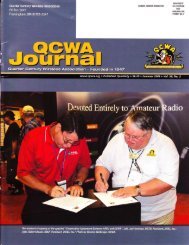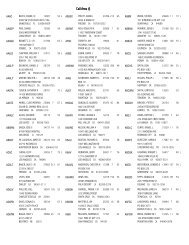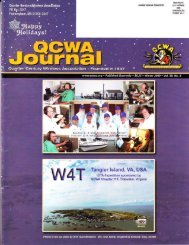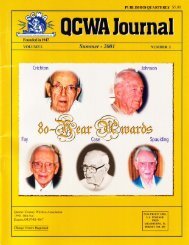Untitled - Quarter Century Wireless Association
Untitled - Quarter Century Wireless Association
Untitled - Quarter Century Wireless Association
Create successful ePaper yourself
Turn your PDF publications into a flip-book with our unique Google optimized e-Paper software.
Robert H. McNamara, Chief of FCC Special Services<br />
Division, advised Vaughan that "...when normal<br />
communications systems are overloaded, damaged or disrupted<br />
because a disaster has occurred, or is likely to occur...an<br />
amateur station may make transmissions necessary to meet<br />
essential communications needs and facilitate relief actions. The<br />
rules also state that when a disaster disrupts normal<br />
communication qystems in a particular area, the FCC Engineerin-Charge<br />
in the area concerned may declare a temporary state<br />
of communication emergency and set forth any special<br />
conditions and special rules to be observed by stations during<br />
the communication emergency." (See Sec. 97.401-407.)<br />
Further, amateur stations are authorized to exchange<br />
emergency messages: (1) with a station in other FCC regulated<br />
Services (Sec. 97.lll(aX2); (2) U.S. Government stations<br />
necessary to providing communications in RACES, the Radio<br />
Amateur Civil Emergenry Service (Sec. 97.111(aX3); and (3) a<br />
station in a service not regulated by the FCC but approved by<br />
the FCC to communicate with amateur stations (Sec.<br />
e7.1 I l(a)(4).<br />
McNamara said the issue of re-transmission of<br />
government broadcasts was also considered in 1989, when the<br />
FCC declined to authorize such re-transmissions because these<br />
transmissions (presumably the emergency or warning<br />
transmissions originated by government or broadcast service<br />
stations) can be widely received using very affordable receivers.<br />
This is still true today, and therefore, the FCC can see no reason<br />
to allow the use ofamateur service frequencies for additional retransmissions.<br />
Rules Amended Concerning 222-225 and 1240-1300 MHz<br />
Bands: On November 30, 1992, the FCC adopted a Notice of<br />
Proposed Rule Making proposing (1) to create a subband in the<br />
222-225 MHz band where repeaters would be prohibited; (2) to<br />
authorize frequency privileges for Novice Class operators in the<br />
entire 222-225 lvfrlz band, and (3) to allow Novice Class<br />
operators to be licensecs and control operators of repeaters in<br />
the 222-225 MHz band as well as in the 12'.10-1295 wlz<br />
segment of the 1240-1300 MHz band. On November 19, 1993,<br />
the Commission adopted the proposed rules on establishment of<br />
a subband and authorization of privileges for Novices in the<br />
entire 222-225 MHz band, but declined to adopt the proposal<br />
relating to Novices as control operators and licensees of<br />
repeaters in either band.<br />
The Commission considered carefully the comments<br />
for and against establishing a protected subband. They agreed<br />
with the ARRL that it is desirable that there be a uniform,<br />
nationwide subband where experimental operations can take<br />
place unaffected by repeater use. The concluded that the public<br />
interest would be served by establishing a protected subband at<br />
222.000-222.150 MHz.<br />
The proposal to expand the privileges of Novice Class<br />
operators by authorizing them the entire 222'225 MHz band<br />
met with a very favorable response from the commentors.<br />
There was general agreement that authorizing Novice<br />
Class operators additional frequenry privileges would provide<br />
an opportunity for them to become proficient in a wider variety<br />
of amateur service operations. In addition, Novice Class<br />
operators will have more flexibility in selecting the mode of<br />
transmission that they want to use.<br />
There was significant opposition to the Commission's<br />
proposal to permit Novice Class operators to serve as licensees<br />
and control operators of repeaters in the 222-225 and 1240-<br />
1300 MHz bands. In view of the lack of substantial suppo( by<br />
the amateur community for granting Norice Class operators<br />
these additional privileges, the Commission deided not to<br />
amend the Rules in this respect. It was note4 in this<br />
connection, that the distinction betrren the Novice and<br />
Technician Classes would be diminished by granting Novices<br />
the proposed repeater privileges.<br />
Vanity Call Sign System Proposed by the FCC: On December<br />
29, 1993, the FCC released a Notice of Proposed Rule Making<br />
(NPRM: PR Docket 93-305) on amendment of the amateur<br />
service Rules to implement a vanity call sign system. This<br />
NPRM marks the beginning of action on the long-awaited<br />
general solution to the matter of requests for "special" call<br />
signs.<br />
The Notice says in part: "Information age technologr is<br />
providing the capability to administer a vanity call sign system<br />
and provide better and more friendly service to our customers.<br />
The Private Radio Bureau's Licensing Division will smn be<br />
installing a new automated licensing process that will provide<br />
greater flexibility in licensing. With the added capability, we<br />
can now propose to amend the rules to implement a system<br />
whereby amateur station licensees could select call signs of their<br />
choice, provided they are not already assigned. This vanity call<br />
sign system would be in addition to the current sequential call<br />
sign system that we would continue to use for those applicants<br />
who do not want a vanity call sign."<br />
Applicants for a vanity call sign would list a maximum<br />
often call signs in order ofpreference. The automated process<br />
would compare the applicant's list with the assigned call signs<br />
in the groups designated in the sequential call sign system /or<br />
the applicant's class o/ operator license. @mphasis ours.) The<br />
first available call sign from the applicant's list would then be<br />
assigned. If none of the call signs listed are available, the<br />
automated process would reassign the call sign that the<br />
applicant had vacated. The vanity call sign(s) listed by the<br />
applicant must be within the /ramework of the sequential call<br />
sign assignment system, wherein certain groups of call signs<br />
are designated for each class of operator license. Applicants,<br />
therefore, could choose call signs from the groups<br />
conesponding to their license classes or lower license classes.<br />
@mphasis ours.)<br />
The Appendix to the NPRM includes proposed new<br />
text for Section 97.L9, to be titled "Application for a vanity call<br />
sign." @xisting Sections 97.L9 et seq would be renumbered.)<br />
The deadline for comments was March 7, 1994, and<br />
for reply comments is April7,1994.<br />
The proposed action overtakes and supersedes an<br />
earlier Order (May 11, 1993) amending the amateur service<br />
rules to establish call sign administrators for club and military<br />
recreation stations. Consequently, the earlier Order was<br />
rescinded by Memorandum Opinion and Order also dated<br />
December 29,1993.<br />
13 Spring 199a



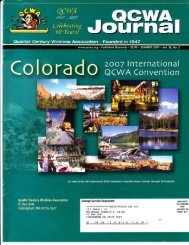
![11{J hI EfifSIt]E I]E - Quarter Century Wireless Association](https://img.yumpu.com/11816560/1/190x245/11j-hi-efifsite-ie-quarter-century-wireless-association.jpg?quality=85)
